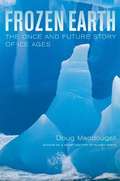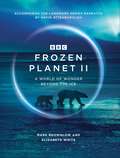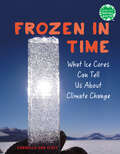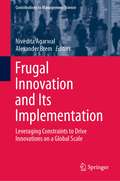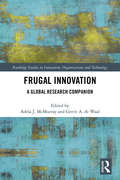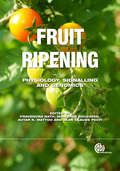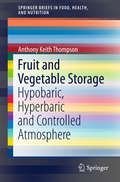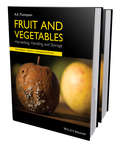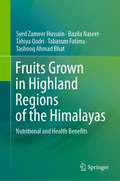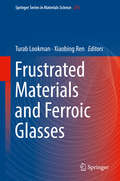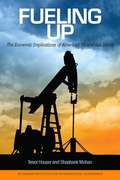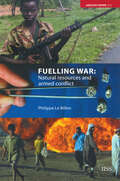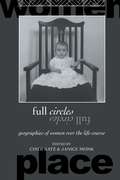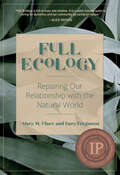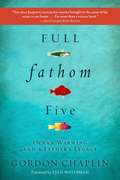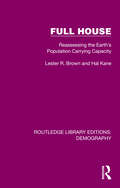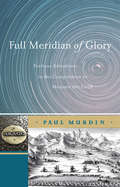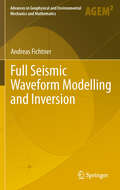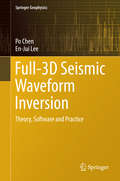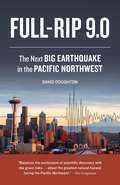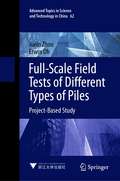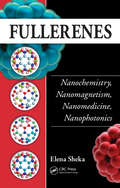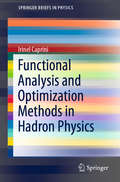- Table View
- List View
Frozen Earth: The Once and Future Story of Ice Ages
by Douglas MacdougallAn accessible account of the nature and global effects of Ice Ages, including the history of how several maverick scientists developed various pieces of our current scientific theory of these times, and how recent studies of Pleistocene climate may help us understand Earth's future climate changes.
Frozen Planet II
by Elizabeth White Mark BrownlowACCOMPANIES THE LANDMARK SERIES NARRATED BY DAVID ATTENBOROUGHFind a world of wonder beyond the ice. 'Looking down at our planet from space it may come as a surprise how much of it is blanketed in snow and ice. These vast frozen wildernesses cover more than a fifth of the earth ... From the highest peaks to snow-bound deserts to alien worlds deep beneath the ice, they are home to an astonishing array of animals found nowhere else on earth.'David Attenborough, from the series.Frozen Planet II celebrates the surprisingly diverse worlds of ice - a world that is disappearing before our very eyes. Previously undiscovered stories, from chameleons giving birth on the frosty slopes of Mount Kenya to endangered Amur leopards in the Russian forest and killer whales hunting Weddell seals on ice floes in the Antarctic, shed new light on the beauty and the peril of the world's most fragile ecosystems. Behind-the-scenes insights explore the unique challenges of filming in these frozen worlds, where camera crew and wildlife alike brave the extreme conditions.With over 250 stunning full-colour photographs, Frozen Planet II reveals the wonders of the fastest-changing part of our planet, as we may never see them again.
Frozen in Time: What Ice Cores Can Tell Us About Climate Change (Books for a Better Earth)
by Carmella Van VleetA dazzling introduction to paleoclimatology for kids, connecting the methods that scientists use to study our climate history with future climate change solutions.Believe it or not, ice isn&’t always just frozen water. In fact, most of the ice covering our planet contains thousands of years' worth of information about our atmosphere. This ice is made up of a lot more than snow—it has soot, volcanic ash, gasses, and other substances that affect the climate. And if we drill a piece of that ice? We get a frozen time capsule, courtesy of Earth. In this exhilarating middle grade nonfiction book by a former educator, kids are immersed in the field of paleoclimatology. Readers go along on an ice core expedition, run through each step in the collecting and transporting process, review the fascinating components of an ice core, and explore the specialized labs where scientists examine them.But these pieces of our planet are more than just cool records. By preserving and studying these frosty collections of climate history, we can learn from previous patterns and better protect our planet in the future. The final chapter focuses on ice as a key tool in the fight against climate change.With crystal-clear explanations and an engaging, kid friendly tone, the book features 15+ full-color photographs, diagrams, interviews with paleoclimatologists, a glossary of terms, and simple experiments for budding scientists at home. Books for a Better Earth are designed to inspire children to become active, knowledgeable participants in caring for the planet they live on.A Junior Library Guild Gold Standard Selection
Frugal Innovation and Its Implementation: Leveraging Constraints to Drive Innovations on a Global Scale (Contributions to Management Science)
by Alexander Brem Nivedita AgarwalThis book discusses several product development strategies and tools employed by organizations around the world to implement frugal innovations. Over the past decade, frugal innovations have caught the attention of countless management scholars. This book comes at the right time for academics and practitioners alike, as it explores how the concept of frugal innovation has evolved over the past several years and is shifting its focus from merely featuring ‘cost’ driven innovations to being more ‘resourceful’ and ‘sustainable’ at its core. Furthermore, in light of the ongoing digital revolution and emergence of new business models such as sharing economy and circular economy, the book highlights recent and upcoming trends and their impacts on frugal innovation strategies.
Frugal Innovation: A Global Research Companion (Routledge Studies in Innovation, Organizations and Technology)
by Adela J. McMurray Gerrit A. De WaalCustomers are increasingly seeking "low-cost, high-quality" or what is known as frugal products that meet the buyer’s needs while reducing the associated cost of ownership. This book examines the developing principles and theories of frugal innovations across the globe. The authors identify frugal innovation (FI) using a multi-method approach to data analysis. They argue that the concept of frugality as a societal/ethical value has undergone several changes and propose a differentiated model of frugal innovations. They address frugal innovations that have never been accessible to the public. Hands-on case studies across multiple industry sectors and countries, supported by theory, provide multiple learning opportunities. The authors explore the relationship between FI and digitalization and technology, and discuss how FI can be applied in the context of contemporary issues such as food security. Further, they articulate the mechanisms by which FI beliefs and values can be incorporated into organizational culture. The final chapters address both ethical and controversial views of frugal innovation. The book is a valuable resource for students in business courses, for industry professionals wanting to improve their triple bottom line, and for educators wanting to influence and change the mind-sets of the younger generations to effectively deal with today’s and tomorrow’s challenges.
Fruit Ripening
by Christopher Davies Véronique Cheynier Autar K. Mattoo Autar Handa Don Grierson Asaph Aharoni Angelos Kannellis Cornelius Barry Mathilde Causse Arun Sharma Hiroshi Ezura Mondher Bouzayen Alisdair Fernie Jean Claude Pech Kunsog Chen Pravendra Nath Abhay Dandekar Joseph Hirschberg Mark Tucker Kailash Bansal Jim Giovannoni Christophe Rothan Giovanni GiulianoFruit ripening is an important aspect of fruit production. The timing of it affects supply chains and buying behaviour, and for consumers ripeness not only affects perceptions of health but has nutritional effects too. Ripeness is closely related to spoilage which has a major financial impact on agricultural industries. Currently there are fast moving developments in knowledge of the factors affecting fruit ripeness, and this up-to-date monograph seeks to draw together the disparate research in this area. The aim of the book is to produce a comprehensive account covering almost every area related to fruit ripening including the latest molecular mechanisms regulating fruit ripening, its impact on human nutrition and emerging research and technologies.
Fruit Ripening: Physiology, Signalling and Genomics
by Christopher Davies Véronique Cheynier Autar Handa Don Grierson Asaph Aharoni Angelos Kannellis Cornelius Barry Mathilde Causse Arun Sharma Hiroshi Ezura Alisdair Fernie Kunsog Chen Joseph Hirschberg Mark Tucker Kailash Bansal Jim Giovannoni Christophe Rothan Giovanni Giuliano Abhaya DandekarFruit ripening is an important aspect of fruit production. The timing of it affects supply chains and buying behaviour, and for consumers ripeness not only affects perceptions of health but has nutritional effects too. Ripeness is closely related to spoilage which has a major financial impact on agricultural industries. Currently there are fast moving developments in knowledge of the factors affecting fruit ripeness, and this up-to-date monograph seeks to draw together the disparate research in this area. The aim of the book is to produce a comprehensive account covering almost every area related to fruit ripening including the latest molecular mechanisms regulating fruit ripening, its impact on human nutrition and emerging research and technologies.
Fruit and Vegetable Storage
by Anthony Keith ThompsonThis Brief reviews the effects of increasing and reducing atmospheric pressure on the postharvest life of fruit and vegetables. The text covers the common methods and technologies used and evaluates the history and benefits of hypobaric and hyperbaric storage. Both of these techniques have the potential to address quantitative and qualitative challenges in the postharvest sector of the fresh fruit and vegetables industry. Hypobaric and Hyperbaric Storage of Fruit and Vegetables reports on the effects of storage on over 45 types of fruit and vegetables, as well as on whole plants and cut flowers. As consumer demand for high quality product increases, proper postharvest storage will continue to gain in importance. The environmental conditions used in storage have a vital influence on the quality, safety and health benefits of fruit and vegetables.
Fruit and Vegetables: Harvesting, Handling and Storage (Springerbriefs In Food, Health, And Nutrition Ser.)
by Anthony Keith ThompsonCompletely revised, updated and enlarged, now encompassing two volumes, this third edition of Fruit and Vegetables reviews and evaluates, in comprehensive detail, postharvest aspects of a very wide international range of fresh fruit and vegetables as it applies to their physiology, quality, technology, harvest maturity determination, harvesting methods, packaging, postharvest treatments, controlled atmosphere storage, ripening and transportation. The new edition of this definitive work, which contains many full colour photographs, and details of species not covered in the previous editions, provides key practical and commercially-oriented information of great use in helping to ensure that fresh fruit and vegetables reach the retailer in optimum condition, with the minimum of deterioration and spoilage. With the constantly increasing experimental work throughout the world the book incorporates salient advances in the context of current work, as well as that dating back over a century, to give options to the reader to choose what is most relevant to their situation and needs. This is important because recommendations in the literature are often conflicting; part of the evaluation of the published results and reviews is to guide the reader to make suitable choices through discussion of the reasons for diverse recommendations. Also included is much more on the nutritional values of fruit and vegetables, and how these may vary and change postharvest. There is also additional information on the origin, domestication and taxonomy of fruit and vegetables, putting recommendations in context. Fruits and Vegetables 3e is essential reading for fruit and vegetable technologists, food scientists and food technologists, agricultural scientists, commercial growers, shippers, packhouse operatives and personnel within packaging companies. Researchers and upper level students in food science, food technology, plant and agricultural sciences will find a great deal of use within this popular book. All libraries in research establishments and universities where these subjects are studied and taught should have copies readily available for users.
Fruits Grown in Highland Regions of the Himalayas: Nutritional and Health Benefits
by Syed Zameer Hussain Bazila Naseer Tahiya Qadri Tabasum Fatima Tashooq Ahmad BhatThis book discusses different fruit crops and provides first-hand information on the nutritional composition of commercially important, as well as unexplored fruits, which are grown in Jammu, Kashmir and Ladakh. A detailed nutritional profile of each fruit is presented in the book. The potential health implications against cardiovascular diseases, diabetes, carcinoma, oxidative damage, asthma, aging and cognition are discussed and explained. Besides, nutritional composition and medicinal implications, origin, morphology, taxonomy and production scenarios of unexplored, as well as commercially important fruits, have also been highlighted in the book. This book will be of interest to students and researchers involved in agricultural sciences, food science, nutrition and the Indian medicine system.
Frustrated Materials and Ferroic Glasses (Springer Series in Materials Science #275)
by Turab Lookman Xiaobing RenThis book provides a comprehensive introduction to ferroics and frustrated materials. Ferroics comprise a range of materials classes with functionalities such as magnetism, polarization, and orbital degrees of freedom and strain. Frustration, due to geometrical constraints, and disorder, due to chemical and/or structural inhomogeneities, can lead to glassy behavior, which has either been directly observed or inferred in a range of materials classes from model systems such as artificial spin ice, shape memory alloys, and ferroelectrics to electronically functional materials such as manganites. Interesting and unusual properties are found to be associated with these glasses and have potential for novel applications. Just as in prototypical spin glass and structural glasses, the elements of frustration and disorder lead to non-ergodocity, history dependence, frequency dependent relaxation behavior, and the presence of inhomogeneous nano clusters or domains. In addition, there are new states of matter, such as spin ice; however, it is still an open question as to whether these systems belong to the same family or universality class.The purpose of this work is to collect in a single volume the range of materials systems with differing functionalities that show many of the common characteristics of geometrical frustration, where interacting degrees of freedom do not fit in a lattice or medium, and glassy behavior is accompanied by additional presence of disorder. The chapters are written by experts in their fields and span experiment and theory, as well as simulations. Frustrated Materials and Ferroic Glasses will be of interest to a wide range of readers in condensed matter physics and materials science.
Fueling Up: The Economic Implications of America's Oil and Gas Boom
by Trevor Houser Shashank MohanNew drilling techniques for oil and natural gas are propelling an energy production renaissance in the United States. As the US economy struggles to emerge from the Great Recession, many see the boom as a possible source of economic salvation that could reduce unemployment and revitalize American manufacturing. Until now, however, there has been little objective analysis of the energy boom's economic consequences.In this major study, Trevor Houser and Shashank Mohan fill that gap. They assess the impact of the recent and projected increase in domestic energy production on US GDP, employment growth, manufacturing competitiveness, household expenditures, and international trade balance. Alongside its economic impact, the American energy revolution is raising new environmental and trade policy questions. What are the consequences for the environment and global warming of increased domestic oil and gas production? Should companies be allowed to export the energy they produce or will doing so undermine American manufacturing competitiveness? Houser and Mohan provide independent research and analysis that will help policymakers navigate these issues.
Fuelling War: Natural Resources and Armed Conflicts (Adelphi series #373)
by Philippe Le BillonA generous endowment of natural resources should favour rapid economic and social development. The experience of countries like Angola and Iraq, however, suggests that resource wealth often proves a curse rather than a blessing. Billions of dollars from resource exploitation benefit repressive regimes and rebel groups, at a massive cost for local populations. This Adelphi Paper analyses the economic and political vulnerability of resource-dependent countries; assesses how resources influence the likelihood and course of conflicts; and discusses current initiatives to improve resource governance in the interest of peace. It concludes that long-term stability in resource-exporting regions will depend on their developmental outcomes, and calls for a broad reform agenda prioritising the basic needs and security of local populations.
Full Circles: Geographies of Women over the Life Course (Routledge International Studies of Women and Place)
by Cindi Katz Janice MonkFull Circles describes the very different lives and expectations of women in post-industrial and developing countries from childhood to old age. Analysing how class, ethnicity, nationality and individual values intersect with the experience of the life course, the book explores the futures open to women in diverse and changing locations.
Full Ecology: Repairing Our Relationship with the Natural World
by Gary Ferguson Mary M. ClareHow to confront the climate crisis without losing heart It’s easy to feel overwhelmed in the face of global climate breakdown. So how might we develop the inner resolve to confront it? Full Ecology, a collaboration between social-cultural psychologist Mary M. Clare and longtime science writer Gary Ferguson, suggests a path forward. Breaking the modern impulse to see humans as separate from nature, Clare and Ferguson encourage us to learn from the &“supremely methodical and highly improvisational&” natural systems that touch our lives. True change, they argue, begins with us stopping and questioning assumptions about our place in the world. From this process of reflection, they offer us an alternative blueprint for acting in ecologically healthy ways, and for inspiring others to do the same. Rather than proposing a ten-step plan to save the earth, this book encourages a more elemental rethinking of our connections to nature, and of how such connections might be strengthened for the common good. Practical and poetic, scientific and spiritual, Full Ecology presents a strong, nourishing foundation for climate action.
Full Fathom Five: Ocean Warming and a Father's Legacy
by Gordon Chaplin Stan Waterman"Not since Jacques Cousteau has anyone brought us the sense of the ocean as our home . . . Far more than a science book.” -San Francisco Book ReviewGordon Chaplin’s father was a seemingly happy-go-lucky, charismatic adventurer who married a wealthy heiress and transformed himself into the author of a landmark scientific study, Fishes of the Bahamas. The book was published by the Academy of Natural Sciences of Philadelphia, one of America's most esteemed scientific institutions. As a young boy, the author took part in collecting specimens for his father. Fifty years later, he was asked to join a team studying the state of sea life in the Bahamian waters where he grew up, as measured against his father’s benchmark.The first of the sea changes presented in this eloquent book stems from climate change and is the drastic transformation of ocean life due to global warming. The second is his father’s miraculous transformation from playboy into scientist. And the third involves the author’s own complicated relationship with his parents, in particular his father, as he grew older and assumed the part of prodigal son. Fifty years later, returning to his childhood home, he delves into the mysteries of his father’s life and the impossibility of ever truly recovering the past or returning home.
Full House: Reassessing the Earth’s Population Carrying Capacity (Routledge Library Editions: Demography #2)
by Lester R. Brown Hal KaneOriginally published in 1995, after decades of steady growth, this book was written at a time when the world’s food supply was no longer keeping up with population increases. This book examines the causes of the imbalance in the food/population equation and suggests ways in which Malthusian checks can be countered. It calls for an international strategy to restore global security, and a budget to implement it, with a massive redirection of the world’s financial resources. On one side of the argument the authors advocate increased expenditure on family planning services, education, and women’s rights. On the other, they stress the environmental importance of reforestation and soil conservation schemes to halt the deterioration of the agricultural resource base.
Full Meridian of Glory
by Paul Murdin[the text below needs editing and we must be careful not to say things about Dan Brown's book that could get Springer in legal trouble] Dan Brown's novel, The Da Vinci Code, was first published in 2003; its sales have reached 40 million worldwide. The book mixes a small spice of fact into a large dollop of fiction to create an entertaining novel of intrigue, adventure, romance, danger and conspiracy, which have been imaginatively worked together to cook up the successful bestseller. Most interest in the book's origins has centred on the sensational religious aspects. Dan Brown has written: 'All of the art, architecture, secret rituals, secret societies, all of that is historical fact.' This gives an air of authenticity to the book. Brown has, however, made up the religious doctrines, or based them on questionable accounts by others. The locations of the actions of The Da Vinci Code are not, however, made up. The present book is the scientific story behind the scene of several of the book's actions that take place on the axis of France that passes through Paris. The Paris Meridian is the name of this location. It is the line running north-south through the astronomical observatory in Paris. One of the original intentions behind the founding of the Paris Observatory was to determine and measure this line. The French government financed the Paris Academy of Sciences to do so in the seventeenth to nineteenth centuries. It employed both astronomers - people who study and measure the stars - and geodesists - people who study and measure the Earth. This book is about what they did and why. It is a true story behind Dan Brown's fiction. This is the first English language presentation of this historical material. It is attractively written and it features the story of the community of scientists who created the Paris Meridian. They knew each other well - some were members of the same families, in one case of four generations. Like scientists everywhere they collaborated and formed alliances; they also split into warring factions and squabbled. They travelled to foreign countries, somehow transcending the national and political disputes, as scientists do now, their eyes fixed on ideas of accuracy, truth and objective, enduring values - save where the reception given to their own work is concerned, when some became blind to high ideals and descended into petty politics. To establish the Paris Meridian, the scientists endured hardship, survived danger and gloried in amazing adventures during a time of turmoil in Europe, the French Revolution and the Napoleonic War between France and Spain. Some were accused of witchcraft. Some of their associates lost their heads on the guillotine. Some died of disease. Some won honour and fame. One became the Head of State in France, albeit for no more than a few weeks. Some found dangerous love in foreign countries. One scientist killed in self defence when attacked by a jealous lover, another was himself killed by a jealous lover, a third brought back a woman to France and then jilted her, whereupon she joined a convent. The scientists worked on practical problems of interest to the government and to the people. They also worked on one of the important intellectual problems of the time, a problem of great interest to their fellow scientists all over the world, nothing less than the theory of universal gravitation. They succeeded in their intellectual work, while touching politics and the affairs of state. Their endeavours have left their marks on the landscape, in art and in literature.
Full Seismic Waveform Modelling and Inversion
by Andreas FichtnerRecent progress in numerical methods and computer science allows us today to simulate the propagation of seismic waves through realistically heterogeneous Earth models with unprecedented accuracy. Full waveform tomography is a tomographic technique that takes advantage of numerical solutions of the elastic wave equation. The accuracy of the numerical solutions and the exploitation of complete waveform information result in tomographic images that are both more realistic and better resolved. This book develops and describes state of the art methodologies covering all aspects of full waveform tomography including methods for the numerical solution of the elastic wave equation, the adjoint method, the design of objective functionals and optimisation schemes. It provides a variety of case studies on all scales from local to global based on a large number of examples involving real data. It is a comprehensive reference on full waveform tomography for advanced students, researchers and professionals.
Full-3D Seismic Waveform Inversion
by Po Chen En-Jui LeeThis book introduces a methodology for solving the seismic inverse problem using purely numerical solutions built on 3D wave equations and which is free of the approximations or simplifications that are common in classical seismic inversion methodologies and therefore applicable to arbitrary 3D geological media and seismic source models. Source codes provided allow readers to experiment with the calculations demonstrated and also explore their own applications.
Full-Rip 9.0: The Next Big Earthquake in the Pacific Northwest
by Sandi DoughtonScientists have identified Seattle, Portland, and Vancouver as the urban centers of what will be the biggest earthquake--the Really Big One--in the continental United States. A quake will happen--in fact it's actually overdue. The Cascadia subduction zone is 750 miles long, running along the Pacific coast from Northern California up to southern British Columbia. In this fascinating book, The Seattle Times science reporter Sandi Doughton introduces readers to the scientists who are dedicated to understanding the way the earth moves and describes what patterns can be identified and how prepared (or not) people are. With a 100% chance of a mega-quake hitting the Pacific Northwest, this fascinating book reports on the scientists who are trying to understand when, where, and just how big THE BIG ONE will be.From the Trade Paperback edition.
Full-Scale Field Tests of Different Types of Piles: Project-Based Study (Advanced Topics in Science and Technology in China #62)
by Erwin Oh Jialin ZhouThis book provides full-scale field tests of different types of pile foundations. For the testing, it includes static load tests which consider various loading orientations, dynamic load tests, inclinometer monitoring and tests that aim to determine the load transfer mechanism of pile foundation. This book also covers the up-to-date popular topic with detailed project studies. This includes the academic investigation of post-grouting technology effect on drilled shaft piles, the research of displacement and non-displacement precast pile foundation, the study of fiber-reinforced polymer material used in the geo-technical environment such as deep excavation pit in tunneling project, and the research of super-long and large diameter pile foundations. These investigations provide essential and academic information for researchers as well as engineers in role of Civil and Geotech. Not only the different types of the piles are studied, but also the relevant theory and literatures are reviewed. In this book, the diagrams are plotted in an easy way and the explanation of the diagrams and tables are described in detail. The research methods corresponding to the practical projects are detailed as well. Hence, it is useful as a reference for the students and researchers in civil and geotechnical engineering.
Fullerenes: Nanochemistry, Nanomagnetism, Nanomedicine, Nanophotonics
by Elena ShekaAt the interface between chemistry, biology, and physics, fullerenes were one of the first objects to be dissected, scanned, and studied by the modern multi-specialty biotech community and are currently thriving in both research and practical application. Other members of the sp2 nanocarbon family, such as nanotubes and graphene, are currently bein
Fully Alive: Using the Lessons of the Amazon to Live Your Mission in Business and Life
by Tyler GageFully Alive tells the story of an astoundingly successful young entrepreneur’s immersion in Amazonian indigenous spirituality, its life-changing impact on him, and how he integrated the lessons he learned to build a successful, socially responsible company, live a purposeful life, and make a difference in the world.Building a start-up is like being thrust into the middle of the Amazon rainforest: living every day on the edge of your comfort zone, vulnerable to the unexpected challenges constantly being thrown your way, and constantly shifting to meet daily demands and do everything and anything you can to survive, let alone thrive. Vulnerable, raw, and deeply transparent, Fully Alive reveals powerful tools and lessons that can teach all of us how to grow toward and beyond our personal edges, no matter our circumstances. Tyler Gage shares his spiritual adventures and the business savvy that helped him create RUNA, a pioneering organization that weaves together the seemingly divergent worlds of Amazonian traditions and modern business, demonstrating how we can dig deeper to bring greater meaning and purpose to our personal and professional pursuits. From suburban youth to immersion in the Amazon to entrepreneurial success, Tyler's journey clearly shows that passion and opportunity can be found in the most unexpected places. Captivated by a rare Amazonian tea leaf called guayusa that had never been commercially produced, Tyler started RUNA to partner with the indigenous people of Ecuador to share its energy and its message with the world. Using the spiritual teachings, lessons, and healing traditions of the Amazon as his guide, Tyler built RUNA from a scrappy start-up into a thriving, multimillion-dollar company that has become one of the fastest-growing beverage companies in the United States. With the help of investors such as Channing Tatum, Leonardo DiCaprio, and Olivia Wilde, RUNA has created a sustainable source of income for more than 3,000 farming families in Ecuador who sustainably grow guayusa in the rainforest. Simultaneously, RUNA has built a rapidly scaling nonprofit organization that is working to create a new future for trade in the Amazon based on respectful exchange and healing, not exploitation and greed. Practical tools and lessons are woven throughout the story of Gage’s successes and failures, offering guidance on how to relate to obstacles as teachers and how to accomplish our personal and professional goals in the often uncertain circumstances we find ourselves in.
Functional Analysis and Optimization Methods in Hadron Physics (SpringerBriefs in Physics)
by Irinel CapriniThis book begins with a brief historical review of the early applications of standard dispersion relations in particle physics. It then presents the modern perspective within the Standard Model, emphasizing the relation of analyticity together with alternative tools applied to strong interactions, such as perturbative and lattice quantum chromodynamics (QCD), as well as chiral perturbation theory. The core of the book argues that, in order to improve the prediction of specific hadronic observables, it is often necessary to resort to methods of complex analysis more sophisticated than the simple Cauchy integral. Accordingly, a separate mathematical chapter is devoted to solving several functional analysis optimization problems. Their applications to physical amplitudes and form factors are discussed in the following chapters, which also demonstrate how to merge the analytic approach with statistical analysis tools. Given its scope, the book offers a valuable guide for researchers working in precision hadronic physics, as well as graduate students who are new to the field.
